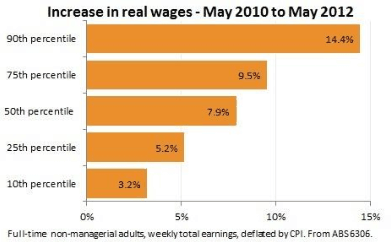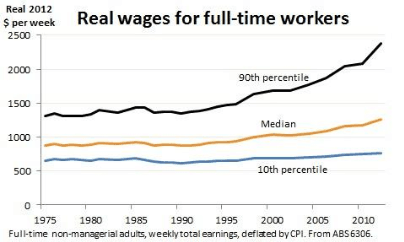
Earlier this week, the Australian Bureau of Statistics (ABS) released biennial earnings data as at May 2012, which contained some interesting facts about the composition of incomes across Australia.
The headline results are as follows:
- In May 2012, the average weekly total cash earnings for all employees were $1,122.60 ($58,375 per year) and for all full-time employees were $1,452.00 ($75,504 per year).
- Median weekly total cash earnings in May 2012 were $963.00 ($50,076 per year) for all employees. One quarter of all employees earned $588.00 ($30,576 per year) or less and one quarter of all employees earned $1,462.00 ($76,024 per year) or more.
- Median weekly total cash earnings for all full-time employees were $1,250.00 ($65,000 per year). One in ten full-time employees received weekly total cash earnings of $738.00 ($38,376 per year) or less while one in ten full-time employees received weekly total cash earnings of $2,364.00 or more ($122,928 per annum).
So, according to the ABS, the median full-time income in Australia ($65,000 per year) was -$10,500 (-14%) less than the average full-time income ($75,504 per year).
And according to the ABS, the top 10% of salary earners experienced the strongest growth in employment incomes over the two years to May 2012 (Chart from Matt Cowgill via Twitter):

As you can see, the lion’s share of employment income growth since the mid-1990s has gone to the top 10% of income earners, whereas the bottom 10% have fared relatively poorly.


